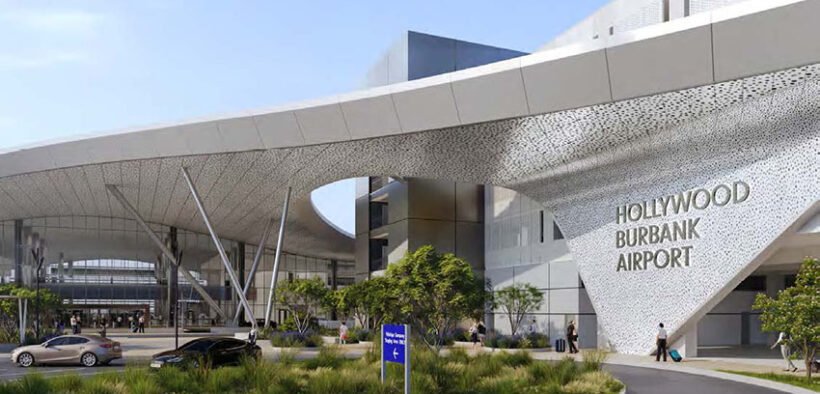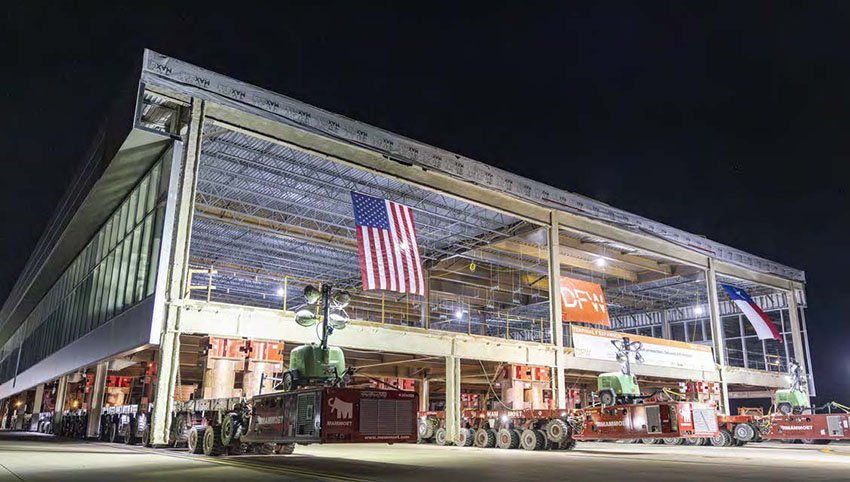Moving forward
Share

We report on the innovative design of Hollywood Burbank Airport’s new terminal and pioneering modular construction at Dallas Fort Worth International Airport.
When the Burbank-Glendale-Pasadena Airport Authority (BGPAA) decided to build a new, state-of-the-art 355,000 square feet terminal at Hollywood Burbank Airport (BUR), Corgan, in association with CannonDesign, was enlisted as the designer of the facility, with the former serving as architect of record for the project.
Inspired by old Hollywood glamour, the modern facility will feature dramatic, sweeping lines with hints of art deco and Mid-Century design — intended to honour the past while embracing the future.
Notable details of the new terminal include a sweeping roof supported by V-shaped columns intended to resemble red-carpet spotlights, exuding elegance and grandeur.
The interior features bronze and champagne-coloured accents, complimenting the openness of the design aesthetic.
With 14 new replacement gates, the terminal will offer localised amenities/retail, centralised check in and security checkpoint, streamlined baggage and kerbside flows, a new airline support facility, and a new six-level parking garage.
BUR will be fully electric – only the second airport in the US to do so –and will pursue LEED Gold. Solar technology will supplement power generation and help to maintain thermal comfort and reduce energy dependency.
An outdoor plaza will minimise water use with native plantings and reuse grey water for irrigation.
Commenting on the terminal’s interior, Corgan says: “Attention to natural light and biophilic elements create a more pleasant experience for passengers while supporting larger sustainability goals for the project.
Full height windows fill the corridors and gate lounges with natural light and frame the Verdugo Mountains, while solar control technology manages heat gain to maintain thermal comfort and reduce energy use.
“Designed for flexibility in passenger and operational needs, the new terminal adds much-needed functionality and safety for the airport while also elevating the design and experience for travellers to the area – balancing a vision for the future with a celebration of its history, technology with human-scale design, and beauty with efficiency.”
To enhance safety, the terminal will be moved away from the runway. The terminal will meet restrictive Risk Category III seismic building codes.
The project broke ground in January 2024, topped out in January 2025, and the anticipated opening is October 2026.

INNOVATIVE MODULE-BASED CONSTRUCTION AT DFW
Elsewhere in the US, Dallas Fort Worth International Airport (DFW) has completed its latest construction milestone by moving six prefabricated module structures that have come together to create the framework for the first phase of the airport’s new Terminal F.
On August 8, the airport completed the last of six module moves that make up the structure for Terminal F.
The modules, some nearly as large as a US football field, were moved overnight during a two-week period using self-propelled modular transporters along one of DFW’s airside taxiways.
The structures were then placed onto the foundations constructed at the Terminal F site, where the facility will now proceed to the next stage of construction.
This is DFW’s third project to deploy the innovative module-based method to reconstruct or expand its terminal facilities, with the most recent moves being the largest modules for a terminal expansion at any airport.
The modules for Terminal F are approximately four times larger than the structures moved earlier this year for the ongoing Terminal C expansion. The largest of the six modules measured 278 feet long by 136 feet wide and weighed 3,320 tons – about as heavy as 12 Boeing 787-9 Dreamliner widebody aircraft.
“By embracing modular construction, we are finding smarter ways to deliver results faster, with less impact on travellers,” noted DFW’s CEO Chris McLaughlin.
“Together with our partners, we are delivering infrastructure through innovation and collaboration that will serve the growing needs of North Texas while setting the stage for the next era of DFW’s development.”
DFW’s executive vice president of infrastructure and development, Mohamed Charkas, added: “DFW is at the forefront of innovation in terminal construction, continually redefining what’s possible.
“The time we save using modular construction techniques is crucial for fostering the growth of our community and supporting our airline partners. We are steadfast in our commitment to being an economic engine for North Texas.”
In May, DFW and American Airlines announced the decision to expand the scope and accelerate the phasing of the new Terminal F.
With the first phase of construction already underway, DFW has been hard at work designing the subsequent phases while concurrently construction the modules offsite.
The first phase of the $4 billion Terminal F expansion programme is anticipated to open with 15 gates in 2027.
It will ultimately deliver a total of 31 gates to be serviced entirely by American Airlines, expanding capacity for international operations and widebody aircraft, and include areas to facilitate parking, ticketing, check-in, security screening and baggage operations.
In addition to a new centralised Skylink Station, which is includedwith the first phase of construction, the final configuration will
provide a walking connection with Terminal D.
The design-build team for the first phase of Terminal F is Innovation Next+, a joint venture comprised Archer Western Construction, Turner Construction Company, Phillips May Corporation, HJ Russell & Company and CARCON Industries, with PGAL, Gensler and Muller2 as design team members.
Hartsfield-Jackson Atlanta International Airport used the same modular construction method for the expansion of Concourse D, moving prefabricated sections into place overnight.







